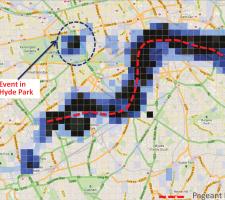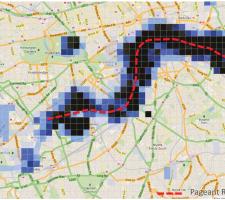
Emerging detection and monitoring solutions can derive information from existing fibre cables buried at the roadside. Pic Highways Agency
Established detection and monitoring technologies continue to evolve, but is it time to challenge their supremacy and take a serious look at less conventional ITS? Andy Graham considers the options with Jason Barnes.
For ITS system providers, the most potentially lucrative markets over the next few years are going to be the BRIC (Brazil Russia India and China) group of countries, all of which are building many miles of new roads, applying tolling to existing ones (8,000km in China alone) and implementing wholly new road tolling and charging schemes. In other parts of the world, as budgets remain squeezed, existing road operators have a need for monitoring solutions with lower whole-life costs than their current technologies allow.Repairing or replacing legacy systems such as loops and cameras requires intrusion into the road surface or other significant work beside or above the road, all of which adds appreciable cost. These factors have the potential to radically re-shape our thinking on what constitutes an effective detection and monitoring capability.
The huge numbers of systems already deployed globally drive some players in the ITS market to focus on providing proven and trusted equipment that interfaces with the legacy back office systems used by mature road operators. But several products which are in development or already on the market replace the point-based sensor data of an inductive loop with other technology that does not require traffic management or in-road installation, and at their core are emulating the data derived from a loop (flow, point speed measurement and so on).
Exploring the options
Newer road markets – including, but not exclusively, the BRIC nations – don’t have – and indeed, aren’t hampered by – legacy traffic systems or sensors. However, they do have high mobile phone penetration – often as a result of skipping the landline phase of telecoms evolution – and an understanding of the role of ITS. This shift to mobile voice and data provides some exciting opportunities for detection and monitoring that uses techniques from outside the traffic industry. The key change is that we should measure people’s movements, not just those of the cars and trucks which they are travelling in.Technologies such as Bluetooth have a lot of merit over established technologies when it comes to identifying passing vehicles; after all, a machine-to-machine radio link is far easier and cheaper to achieve than reading characters on a plate. Other developments include mobile phone monitoring, as was pioneered by
That could be a fibre installed for traffic or tolling, but more often one installed by a telco to support data businesses and which uses the road as a convenient route. Roadside fibre use by telcos isn’t new – road operators in New Zealand and France have turned fibre at the roadside for ITS into a revenue stream and not just a cost centre. Using it as a traffic monitoring tool is something of a revolution, however.
Trials are currently underway of both of these technologies. They require no new equipment at the roadside and can offer added data, such as origin-destination information from mobile phones and general infrastructure monitoring from fibre.
Fibre detection in particular offers the intriguing possibility to detect the acoustic signature of an accident happening, rather than looking to surmise that something has occurred by using loops and cameras to detect the queues which result. This would be a new tool for traffic operators, and one which has the potential to improve incident response times and smooth operations.
Road tolling systems – including DSRC but especially GNSS – also offer an untapped mine of data for road operators, with the equipment and communications already paid for. Of course, companies like INRIX and
Addressing conservatism
Traffic managers will often express concerns about completeness and accuracy of data but this is often just a mind-set issue, one of a (rightly) conservative market which needs hard evidence of new developments’ effectiveness. Loops and cameras, by comparison with the ‘black art’ of mobile telephony, are well understood. Older ITS hands will remember that the adoption of licence plate recognition was also slow as the market took time to build trust.The sensor (and thinking) shift needs to be away from dedicated infrastructure to the vehicles or objects inside them, such as mobile phones, or to the use of other infrastructure such as fibre and wireless networks. This saves cost and increases data coverage. For example, the fibre system from Optasense can cover an entire road, with one detector every 40km measuring data every 10 metres. This is far more coverage than loops or CCTV can provide and it has other benefits too, such as detecting road faults and adding security.
Traffic management operators remain wedded to camera technology, as pictures can be used for a host of tasks ranging from incident verification to monitoring security and weather. They are unlikely to change this opinion even with the most sensor-rich highways. But as more and more cameras are deployed, and as wireless communications and lower power needs make it easier to deploy cameras in locations which were previously difficult or impossible to reach, the age-old problem of which ones to take notice of in a crowded control room will get worse. New data sources used with data fusion techniques can help machine vision systems reach the performance needed without the levels of false alarms that the market wants to avoid. One size of data does not fit all users.
In some cases, therefore, these new solutions will complement and not wholly replace. For real-time operations we will still need vision systems, loops and radar to support legacy systems, and means of providing accurate counts for statistical purposes. But for new roads operators wanting to monitor journey times and react to incidents, new ‘non-road’ technologies can offer a far lower whole-life cost solution. And we haven’t even started to fully explore the data from vehicle-to-vehicle-based systems and how to weave that into traffic operations.
Defining business models
Increasingly, such new data can be provided as a service to a road operator by a third party on a pay-per-year basis against agreed service levels. This is an attractive alternative to having to procure and maintain equipment with an upfront capital expenditure. The market is sometimes worried about data ownership and being reliant on a supplier, rather than owning its own equipment, but again this is more the result of a conservative mind-set than of any real issue. Does a traffic management organisation worry about having single electricity or telecoms suppliers, or even a single supplier of its IT operating systems? As more and more data is held in the cloud this reluctance may reduce, and contractual mechanisms and working with data providers to understand their redundancy of supply can often overcome these comfort issues. GPS is again seen as a single point of failure, but as most fleet management systems have some form of back-up (often using mobile phones) this risk is reduced – and even more so with Galileo coming on line.It’s relatively easy for the ITS ‘late developers’ to avoid having to link to legacy systems and jump to new technologies but what about existing markets? May there be at some stage a business case for the radical step of abandoning the old and running completely with the new? That’s unlikely in the short term as there is simply too much investment in existing systems that work ‘well enough’. But as we want to move towards co-operative networks of vehicles and roads, how will operators remain ‘in the loop’…?
- Andy Graham of
6911 White Willow Consulting Ltd is a Visiting Fellow of the City University London Transport Hub and Chair of the ITS-UK Co-operative Vehicle Highway System Group













